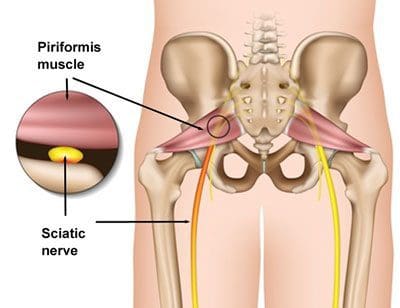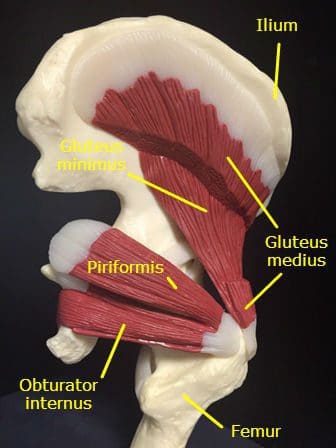Sciatica vs Piriformis Syndrome Explained | El Paso, TX.
Sciatica
Sciatica vs. Piriformis Syndrome: Sciatica is identified as a group of symptoms occurring when the sciatic nerve found on the lumbar region of the spine becomes irritated. The most commonly diagnosed cause of sciatic nerve irritation, or sciatica, results from compression or impingement of a single or multiple nerve roots caused by natural spinal degeneration with age or a disc herniation in the lower back, which may occur after trauma from an injury. The symptoms of sciatica generally originate in the buttock area and, depending on the grade of the underlying nerve compression and inflammation, and sciatic nerve irritation may radiate down the entire leg into the ankle and foot.
What Is Piriformis Syndrome?
Piriformis syndrome is a condition in which the piriformis muscle, found in the buttock region from the upper femur bone to the edge of the sacrum or the pelvic bone below the lumbar spine, contracts, and spasms, causing pain and tightness as well as tingling and numbness. The symptoms of piriformis syndrome are very similar and are often closely associated with sciatica. In some cases, the condition actually causes sciatic nerve irritation. Because the sciatic nerve runs underneath or through the middle of the piriformis muscle, contraction or inflammation of the tissues in this area may compress the sciatic nerve and develop sciatica symptoms. This is one of the main reasons when sciatica vs. piriformis syndrome gets misdiagnosed.

As previously mentioned, the symptoms of sciatica and piriformis syndrome are very similar. Both cause pain, tingling and burning sensations, and/or numbness down the affected leg, radiating down into the foot. Furthermore, this set of symptoms and the condition tend to closely correlate to biomechanical functional complications in the joints of the back and pelvis. Sciatica and piriformis syndrome may even be present simultaneously in the same person who can make telling both complications apart more difficult.
Consequently, though, because the most effective treatment options for sciatica and piriformis syndrome vary considerably from each other, it is ultimately essential to receive a proper analysis to determine the correct diagnosis of your symptoms. In most cases, there is an easy way to distinguish when sciatica vs. piriformis syndrome.
When the problem is one condition versus the other and not both conditions simultaneously, two simple methods will help verify the presence of sciatica apart from piriformis syndrome. First, while in a seated position, if the individual straightens the affected leg so that the leg is parallel to the floor and the sciatica symptoms increase, this could suggest the presence of sciatica or true sciatic nerve irritation. Then, for the second method, from a sitting position as well, the individual should first bend the affected leg and pull their knee towards the same-side shoulder. There should not be a major increase in pain in all but the most severe cases while in this position. Continuing with this same method, the individual should then pull their knee towards the opposite shoulder. An increase in sciatica-like symptoms is a strong indication of piriformis syndrome.
Treatment When Sciatica vs. Piriformis Syndrome

Treatment for piriformis syndrome entails decreasing the intensity of the piriformis muscle spasm that’s controlling the sciatic nerve. Trigger point therapy, massage therapy, ice, heat, electrical, and stretching are involved in the early stages of care. Deep massage therapy is not advised in the first phases of piriformis syndrome. Some of the pain may be relieved during the therapy, but individuals experience worsening symptoms the following day. After the piriformis muscle is worked deeply, it might relax for a short time period before it goes to a bigger spasm, further worsening the gastrointestinal pain.
Both piriformis syndrome and spinal disc herniations produce radiating pain in the shallow back and leg. They are two different injuries, requiring treatments for recovery and regular healing. They are both commonly associated with flexibility and low back weakness. Treatment should address the acute traumas but also the core weaknesses that resulted in the condition.
If you’re experiencing any form of symptoms that may be causing you pain and discomfort, it’s crucial to seek immediate medical attention to determine the presence of any other underlying condition that may be causing the symptoms. A chiropractor focuses on diagnosing and treating a wide variety of musculoskeletal injuries or conditions, including sciatica. Through a series of spinal adjustments and manual manipulations, chiropractic care can gradually restore the individual’s natural health by relieving the stress and pressure placed on the spine, causing pain and discomfort.
Sciatica Specialist
Post Disclaimer
Professional Scope of Practice *
The information herein on "Sciatica vs Piriformis Syndrome Explained | El Paso, TX." is not intended to replace a one-on-one relationship with a qualified health care professional or licensed physician and is not medical advice. We encourage you to make healthcare decisions based on your research and partnership with a qualified healthcare professional.
Blog Information & Scope Discussions
Our information scope is limited to Chiropractic, musculoskeletal, acupuncture, physical medicines, wellness, contributing etiological viscerosomatic disturbances within clinical presentations, associated somatovisceral reflex clinical dynamics, subluxation complexes, sensitive health issues, and/or functional medicine articles, topics, and discussions.
We provide and present clinical collaboration with specialists from various disciplines. Each specialist is governed by their professional scope of practice and their jurisdiction of licensure. We use functional health & wellness protocols to treat and support care for the injuries or disorders of the musculoskeletal system.
Our videos, posts, topics, subjects, and insights cover clinical matters, issues, and topics that relate to and directly or indirectly support our clinical scope of practice.*
Our office has reasonably attempted to provide supportive citations and has identified the relevant research studies supporting our posts. We provide copies of supporting research studies available to regulatory boards and the public upon request.
We understand that we cover matters that require an additional explanation of how it may assist in a particular care plan or treatment protocol; therefore, to further discuss the subject matter above, please feel free to ask Dr. Alex Jimenez, DC, or contact us at 915-850-0900.
We are here to help you and your family.
Blessings
Dr. Alex Jimenez DC, MSACP, RN*, CCST, IFMCP*, CIFM*, ATN*
email: coach@elpasofunctionalmedicine.com
Licensed as a Doctor of Chiropractic (DC) in Texas & New Mexico*
Texas DC License # TX5807, New Mexico DC License # NM-DC2182
Licensed as a Registered Nurse (RN*) in Florida
Florida License RN License # RN9617241 (Control No. 3558029)
Compact Status: Multi-State License: Authorized to Practice in 40 States*
Presently Matriculated: ICHS: MSN* FNP (Family Nurse Practitioner Program)
Dr. Alex Jimenez DC, MSACP, RN* CIFM*, IFMCP*, ATN*, CCST
My Digital Business Card

